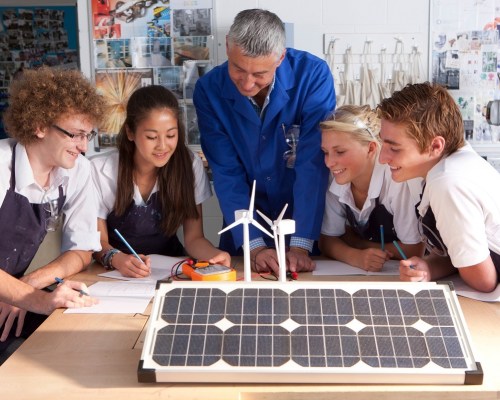Funding Energy Initiatives: A Reflection on Pandemic Era Financing Innovation
Nowadays, we seem to be living in two worlds, caught between a longing for pre-pandemic culture and the wish for a different tomorrow. I feel we are in a very similar situation regarding energy and sustainability in education. We celebrate our successes from the Y2K era while acknowledging the need for a paradigm shift that refocuses our approach. So, the question is: How can we be more successful and productive in the post-pandemic sustainability era?
Regardless of how much you spend on off-site renewables or Renewable Energy Credits, true progress on energy reduction can’t happen with outdated and inefficient infrastructure. To move the needle and get a good return on investment (ROI), campuses will need to reduce energy use through deep energy retrofits and long-term risk mitigation.
Consider these risk elements as you work toward reaching your long-term goals:
- Skilled labor – The ability to recruit, retain and supervise staff to meet project needs over the ROI of a project.
- Capable technical supervision – The ability to hire supervisors capable of monitoring performance of staff related to specific project outcomes.
- Narrow perspectives – Staff in place often lack a broader perspective that is required to optimize project outcomes. Hiring to gain a broader perspective can be inefficient.
- Project focus – Inevitably, staffing changes take place, people are refocused to other projects, positions are cut and attention to operational success is missed.
- Manufacturer leverage – Involvement and contractual responsibilities to vendors are often not managed across the life of projects.
- Required funding – There is a great risk that funding to maintain efficiency will not be available across time.
Let’s take a closer look at how the shift from planning facilities projects to delivering long-term facilities outcomes is paramount in sustainability success. Your campus can better measure success and manage risks by contracting for outcomes that are critical to your sustainability plans. This method shifts the risks to trusted energy providers who can focus on maintenance and performance over the life of the assets.
The current facilities landscape
Prior to beginning my journey in energy and sustainability, I spent 30 years serving as a facilities executive in higher education. I worked at a regional university serving about 5,000 students. We were an average university that faced the common struggles of higher education today – lack of capital, pressures to keep tuition down and the challenge to develop programs and facilities that recruit and retain students. Let’s not forget the never-ending pressure to keep up with our competitors – other universities.
The realities of financial pressures on facilities for most campus operations has led to a cycle of deferred maintenance that frustrates carbon reduction initiatives and stresses utility budgets. In my current role, I’ve traveled our nation, walking mechanical rooms of colleges and universities. I’ve seen firsthand where infrastructure is working for institutions – and where, despite the talented facilities, energy, and sustainability specialist employees, some campuses are struggling. They suffer from:
- The lack of capital for comprehensive improvements
- The absence of consistent talent and supervision to deliver desired sustainability outcomes
- The difficulty in maintaining focus on a project throughout its useful life span – often 20 or more years
We’ve seen some significant changes in how we work and collaborate during this pandemic. But for many campus facilities, the challenges around infrastructure have not been a part of pandemic workplace innovations. And they continue to disrupt institutions’ ability to succeed in reaching their net-zero goals.
The causes of the cycle of deferred maintenance are understandable – past financing strategies for facilities were focused on one-off projects. They didn’t provide adequate capital or operations funds for processes to remain efficient over the asset life span.
This is compounded by the fact that board members rotate regularly, curriculums evolve, administrators come and go, and budgets change reactively and sometimes abruptly. While this fluid environment supports learning, it can cause havoc when delivering outcomes in facilities and sustainability.
Can we talk collaboration?
Campus operations rarely allow us the time and reporting structures that incentivize good communication across institutional departments. This can lead to fragmented planning, which can impair innovation and progress across time. This takes place because:
- Employees focus on their turf and can be defensive of operations – Consider facilitators to work beyond fears.
- Open and honest dialogue can be difficult – Allow time for participants to develop trust in the process.
- It is difficult to quantify financial impact from historical data and correlate to future investments. This can lead to analysis paralysis. Seek to gain financial insights from the collaboration process.
- Lack of time for administrative focus. The more complicated a decision is, the more common it is that decisions are deferred. Consider admin participation in the process to allow for context in decision-making.
By creating a safe space for dialogue across divisions, we can bring down the barriers for innovation and create a pathway to the data that can allow for fact-based costing models. I recently published an article to this point called “The Unguarded Truth.” It’s time to bring down the barriers and for institutions to use fact-based costing models – and for them to offer diverse teammates a seat at the table.
The road ahead …
What’s the most successful model I’ve seen? Institutions with an interdisciplinary team of facilities decision-makers, academics, students and finance team members. When these leaders transparently examine the areas where innovation is required to deliver outcomes, campuses win. But this only really works when the C-suite also invests time and resources in the process. It’s a formula for success that can help us all build a better and greener campus for tomorrow.
Public/private partnership (P3) is a financing trend that fills the news with stories of how large campus operations have taken advantage of shifting the project risks of facility and energy plant renewal to external vendors. While these deals are often complex and require significant investments in legal, financial, and engineering consultants, there is a simpler version of this process available to colleges and universities.
I’m talking about Energy as a Service agreements (EaaS). They’re similar to P3 contracts but require little to no upfront expenses or costly consultants. There are many firms, such as Duke Energy Sustainable Solutions, that can quickly and efficiently help you assess your infrastructure and identify project scope. Then, we can design, build and maintain assets to deliver outcomes for the next 20+ years.
The U.S. Department of Energy writes that these programs can be ideal for the school that “wants a pay-for-performance solution where a third party takes on performance risk and provides project management and maintenance.”
Another industry resource, Guidehouse Insights writes, “EaaS solutions are uniquely positioned to meet customers’ sustainability needs by transferring risk and including guarantees in the contract, simplifying operations, and ensuring a comprehensive and flexible technology solution. The financing element of EaaS, which focuses on OPEX-based payments rather than the use of CAPEX or debt, has been emerging as a critical value proposition of EaaS in a time of financial uncertainty and reluctance to spend CAPEX or take on debt for non-core elements of business.”
It’s a simple answer that can help campuses reach their goals and renew their infrastructure. Now, to recap…
How to break the cycle
1. Examine your past, recognize what wasn’t working and innovate for the future – Take advantage of the pandemic culture shift toward innovation.
2. Switch from projects to initiatives – Look at what is needed to turn energy and sustainability plans into initiatives that transcend risks over time to deliver outcomes.
3. Collaborate with authority – Understand how organizational processes, structure and project confusion can delay progress. Then champion an energy innovation team to develop your initiatives. Be sure to have regular C-suite engagement.
4. Partner to assess for success – Find a trusted vendor who can help lead the process of turning projects into initiatives.
5. Leverage new financing models – Understand the power of public/private partnership. Remember, these can be complex and expensive or streamlined and efficient. Consider vendors who deliver P3 through innovative Energy as a Service contracts. These processes combine consulting, engineering, assessment, design, financing and construction into a single flexible agreement. As a service is ideal for projects ranging from $1M to $100M or more.
Wayne Johnson is key segment manager for Duke Energy Sustainable Solutions. Wayne is a veteran facilities administrator and works to bring education leaders together across the nation to make an impact on energy and sustainability. Wayne consults with colleges, universities and K-12 school leaders at no cost to help them navigate the clean energy transition.
Learn five tips for taking on energy and sustainability for schools and if your leadership is ready to take the next steps, reach out to schedule a free one-hour consultation.



